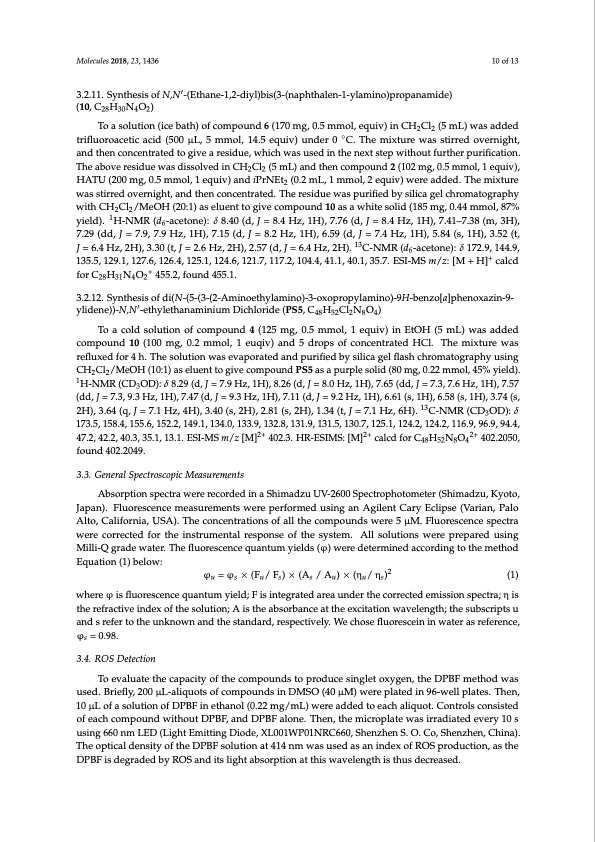
PDF Publication Title:
Text from PDF Page: 010
Molecules 2018, 23, 1436 10 of 13 3.2.11. Synthesis of N,N′-(Ethane-1,2-diyl)bis(3-(naphthalen-1-ylamino)propanamide) (10, C28H30N4O2) To a solution (ice bath) of compound 6 (170 mg, 0.5 mmol, equiv) in CH2Cl2 (5 mL) was added trifluoroacetic acid (500 μL, 5 mmol, 14.5 equiv) under 0 ◦C. The mixture was stirred overnight, and then concentrated to give a residue, which was used in the next step without further purification. The above residue was dissolved in CH2Cl2 (5 mL) and then compound 2 (102 mg, 0.5 mmol, 1 equiv), HATU (200 mg, 0.5 mmol, 1 equiv) and iPrNEt2 (0.2 mL, 1 mmol, 2 equiv) were added. The mixture was stirred overnight, and then concentrated. The residue was purified by silica gel chromatography with CH2Cl2/MeOH (20:1) as eluent to give compound 10 as a white solid (185 mg, 0.44 mmol, 87% yield). 1H-NMR (d6-acetone): δ 8.40 (d, J = 8.4 Hz, 1H), 7.76 (d, J = 8.4 Hz, 1H), 7.41–7.38 (m, 3H), 7.29 (dd, J = 7.9, 7.9 Hz, 1H), 7.15 (d, J = 8.2 Hz, 1H), 6.59 (d, J = 7.4 Hz, 1H), 5.84 (s, 1H), 3.52 (t, J = 6.4 Hz, 2H), 3.30 (t, J = 2.6 Hz, 2H), 2.57 (d, J = 6.4 Hz, 2H). 13C-NMR (d6-acetone): δ 172.9, 144.9, 135.5, 129.1, 127.6, 126.4, 125.1, 124.6, 121.7, 117.2, 104.4, 41.1, 40.1, 35.7. ESI-MS m/z: [M + H]+ calcd for C28H31N4O2+ 455.2, found 455.1. 3.2.12. Synthesis of di(N-(5-(3-(2-Aminoethylamino)-3-oxopropylamino)-9H-benzo[a]phenoxazin-9- ylidene))-N,N′-ethylethanaminium Dichloride (PS5, C48H52Cl2N8O4) To a cold solution of compound 4 (125 mg, 0.5 mmol, 1 equiv) in EtOH (5 mL) was added compound 10 (100 mg, 0.2 mmol, 1 euqiv) and 5 drops of concentrated HCl. The mixture was refluxed for 4 h. The solution was evaporated and purified by silica gel flash chromatography using CH2Cl2/MeOH (10:1) as eluent to give compound PS5 as a purple solid (80 mg, 0.22 mmol, 45% yield). 1H-NMR (CD3OD): δ 8.29 (d, J = 7.9 Hz, 1H), 8.26 (d, J = 8.0 Hz, 1H), 7.65 (dd, J = 7.3, 7.6 Hz, 1H), 7.57 (dd, J = 7.3, 9.3 Hz, 1H), 7.47 (d, J = 9.3 Hz, 1H), 7.11 (d, J = 9.2 Hz, 1H), 6.61 (s, 1H), 6.58 (s, 1H), 3.74 (s, 2H), 3.64 (q, J = 7.1 Hz, 4H), 3.40 (s, 2H), 2.81 (s, 2H), 1.34 (t, J = 7.1 Hz, 6H). 13C-NMR (CD3OD): δ 173.5, 158.4, 155.6, 152.2, 149.1, 134.0, 133.9, 132.8, 131.9, 131.5, 130.7, 125.1, 124.2, 124.2, 116.9, 96.9, 94.4, 47.2, 42.2, 40.3, 35.1, 13.1. ESI-MS m/z [M]2+ 402.3. HR-ESIMS: [M]2+ calcd for C48H52N8O42+ 402.2050, found 402.2049. 3.3. General Spectroscopic Measurements Absorption spectra were recorded in a Shimadzu UV-2600 Spectrophotometer (Shimadzu, Kyoto, Japan). Fluorescence measurements were performed using an Agilent Cary Eclipse (Varian, Palo Alto, California, USA). The concentrations of all the compounds were 5 μM. Fluorescence spectra were corrected for the instrumental response of the system. All solutions were prepared using Milli-Q grade water. The fluorescence quantum yields (φ) were determined according to the method Equation (1) below: φu =φs ×(Fu/Fs)×(As /Au)×(ηu/ηs)2 (1) where φ is fluorescence quantum yield; F is integrated area under the corrected emission spectra; η is the refractive index of the solution; A is the absorbance at the excitation wavelength; the subscripts u and s refer to the unknown and the standard, respectively. We chose fluorescein in water as reference, φs = 0.98. 3.4. ROS Detection To evaluate the capacity of the compounds to produce singlet oxygen, the DPBF method was used. Briefly, 200 μL-aliquots of compounds in DMSO (40 μM) were plated in 96-well plates. Then, 10 μL of a solution of DPBF in ethanol (0.22 mg/mL) were added to each aliquot. Controls consisted of each compound without DPBF, and DPBF alone. Then, the microplate was irradiated every 10 s using 660 nm LED (Light Emitting Diode, XL001WP01NRC660, Shenzhen S. O. Co, Shenzhen, China). The optical density of the DPBF solution at 414 nm was used as an index of ROS production, as the DPBF is degraded by ROS and its light absorption at this wavelength is thus decreased.PDF Image | Photosensitizers for Anticancer Photodynamic Therapy

PDF Search Title:
Photosensitizers for Anticancer Photodynamic TherapyOriginal File Name Searched:
molecules-23-01436-v2.pdfDIY PDF Search: Google It | Yahoo | Bing
Cruise Ship Reviews | Luxury Resort | Jet | Yacht | and Travel Tech More Info
Cruising Review Topics and Articles More Info
Software based on Filemaker for the travel industry More Info
The Burgenstock Resort: Reviews on CruisingReview website... More Info
Resort Reviews: World Class resorts... More Info
The Riffelalp Resort: Reviews on CruisingReview website... More Info
| CONTACT TEL: 608-238-6001 Email: greg@cruisingreview.com | RSS | AMP |